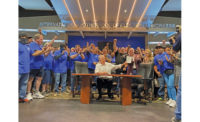What has been dubbed the “New Nevada” now meets the Old West in the state’s hardscrabble mining communities like Beatty and Tonopah. There, electric vehicle charging stations can be found amid the last-chance saloons, sagging buildings and “haunted” hotels typical of fading boomtowns.
Those stations are a product of the Nevada Electric Highway, an initiative that began in 2015 after Tesla decided to build its $5-billion Gigafactory in the state.
The first phase of the NEH saw EV charging stations installed along the 450 rural miles of U.S. Highway 95 linking the state’s two big population centers—Las Vegas and Reno, home of the Gigafactory.
Now, the second phase of the electric highway is developing new charging sites in rural Nevada and adding capacity along Interstate 15, which runs through Las Vegas.
“It’s an important improvement to our infrastructure that sends a message to Nevadans and those who come to and through Nevada that [electric vehicle] ‘range anxiety’ should not be a factor,” says state Sen. Chris Brooks, a Las Vegas Democrat and major voice on energy, clean tech and environmental issues.
As a member of the U.S. Climate Alliance and by state statute, Nevada has pledged to remain in line with the Paris Climate Agreement and cut greenhouse emissions nearly in half by 2030.
“For us to get to those goals, we’re going to need to do a lot of things,” Brooks says. “One of those is to electrify transportation, which is our state’s biggest emitter of greenhouse gasses.”
Begun by former Gov. Brian Sandoval, a Republican, the electric highway has been adopted by his successor, Gov. Steve Sisolak, a Democrat, who took office in early 2019 with an ambitious green agenda. The NEH originally involved the Governor’s Office of Energy; the Nevada Dept. of Transportation; NV Energy, the state’s major electric utility; and rural power providers.
“Our support of the Nevada Electric Highway aligns with NV Energy’s own goals to bring more clean energy options to our customers,” says Sarah Chatteree, NV Energy’s director of renewable energy programs. “We have two sites already complete and are currently developing up to 13 additional charging stations at NEH sites throughout the state, which we plan to have completed by the end of 2020,” she says.
With the utilities and government underwriting the costs, the original sets of chargers are free for public use for the first five years of operations. Subsequent rates will be set by owners of the charging locations, typically gas stations and convenience stores. For the second phase and beyond, all charging costs will be determined by site owners.
Connecticut-based Verdek, a national charging station contractor, installed the U.S. 95 sites and is seeking additional work as the NEH expands beyond its eight current stations. Verdek founder and CEO Guy Mannino says one challenge is developing a standard language for permits and other official documents in several rural counties where the next round of charging stations will be located.
“We would prefer [a faster] permitting process, but we understand that applications for EV chargers are a novelty in many counties,” Mannino says.
His company develops the sites “soup to nuts,” he says, but his firm does have a database of more than 400 subcontractors nationwide, particularly engineering and other vendors that are familiar with specific jurisdictions.
Phase 2 of the project began in 2017 with plans to cover more heavily traveled corridors and the vast interior. The state set aside $3.7 million in settlement funds from the Volkswagen emissions scandal for the second phase. Regulators also approved NV Energy’s proposal for the utility to invest up to $500,000 per station along the electric highway.
Officials are planning to add new stations along Interstate 80, which crosses Northern Nevada; U.S. Highway 50, dubbed the loneliest road in America; U.S. Highway 93 through eastern Nevada; and along Interstate 15.
“Siting charging locations can be challenging, since Nevada encompasses 110,000 square miles,” says Kristina Swallow, director of the Nevada Dept. of Transportation. “As a result, finding appropriate charging locations can be tricky due to broad spans between available infrastructure coupled with the needed station requirements, including safety, power and access.”
Still, state officials expect the bulk of the planned electric highway chargers either to be complete or in development by the end of 2020.
“The Nevada Electric Highway provides an important tool for achieving our state’s climate and economic development goals and securing Nevada’s role as a keystone state for transportation electrification,” says David Bobzien, director of the Nevada Governor’s Office of Energy. “This project also highlights strong partnerships between Nevada’s agencies, utilities and private industry.”
In November, the electric highway opened a charging station in Jean, just outside the bright lights of Las Vegas. The small commercial town sits 30 miles south of Las Vegas and a dozen miles north of the California border, along Interstate 15.
Completion in the next few weeks of another NEH charging station north of Las Vegas in Mesquite will allow the state to have its 124-mile stretch of I-15 designated as an “alternative-fuel corridor” by the Federal Highway Administration, which certifies the availability of charging stations.
Interstate 15 carries the bulk of the 10 million visitors who come to Las Vegas annually from Southern California, and range anxiety could deter potential visitors who are part of the Golden State’s large and fast-growing EV community.
All-electric vehicles are more popular in California than anywhere else in the country, with nearly 200,000 registered. That’s 10 times more than the next closest state, Washington, and 60 times more than Nevada, according to federal figures.
“Despite its small population, Nevada could be a linchpin in greater acceptance of EVs,” says Las Vegas-based energy consultant Marie Steele, co-author of an official state blueprint on the electrification of transportation.
“By pursuing the electric highway, joining regional EV alliances and promoting zero-emission transportation, Nevada can pull the EV market out of California and across the country through Tahoe and Reno in the north and Las Vegas in the south,” she says.
Steele, also the former manager of NV Energy’s EV program, adds, “And with the range of EVs improving and their numbers growing, investing in charging stations and other infrastructure is a necessity rather than an option.”





Post a comment to this article
Report Abusive Comment